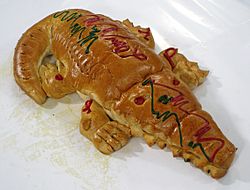Roti buaya facts for kids

Roti Buaya in the shape of a crocodile
|
|
| Type | Snack, appetizer, dessert |
|---|---|
| Place of origin | Indonesia |
| Region or state | Jakarta, Banten, West Java |
Roti buaya (which means "Crocodile bread" in English) is a special kind of sweetened bread from the Betawi people in Indonesia. It's shaped like a crocodile and usually comes in two pieces. This unique bread is always a part of traditional Betawi wedding parties.
History of Roti Buaya
Long ago, Europeans like the Portuguese and Dutch came to Batavia (which is now Jakarta). They brought with them the idea of making bread and pastries. Before they arrived, people in the area already made crocodile-shaped dishes. These older versions were made from local plants like yams or cassava.
The roti buaya we know today was created during the time when Indonesia was a Dutch colony. It was influenced by Dutch cooking. Many other Indonesian dishes also got ideas from Dutch food. Some examples include selat solo (a type of Solo salad), macaroni schotel (macaroni casserole), and pastel tutup (like Shepherd's pie).
What Roti Buaya Symbolizes
The Betawi people believe that crocodiles choose only one partner for life. Because of this, roti buaya is a symbol of being loyal and faithful in marriage. It shows that a husband and wife will always be true to each other.
During a wedding, guests often look at the bread on the bride's side. How the bread looks can be seen as a sign of the groom's personality. Crocodiles are also known for being very patient. So, the bread also represents patience. Besides loyalty and patience, roti buaya can also symbolize being financially stable.
However, in modern times, the meaning of the crocodile symbol has changed a bit. Sometimes, a crocodile can refer to someone who is not loyal or honest. For example, it might describe someone who doesn't keep their promises. Another idea is that the bread shows strength and manliness.

